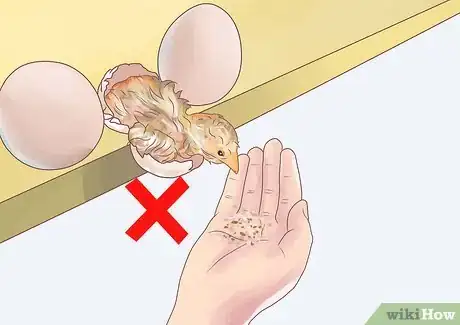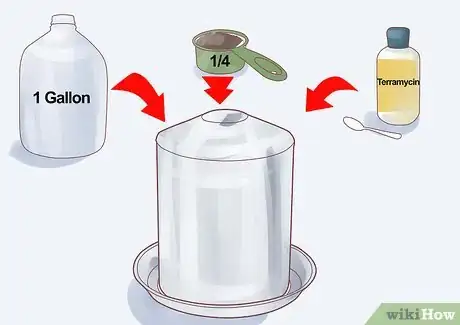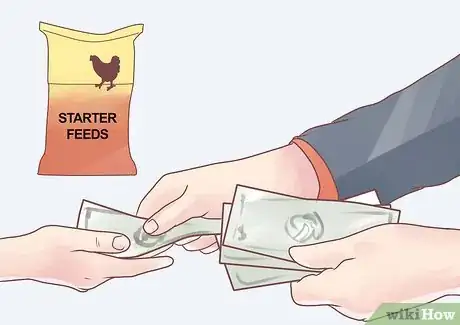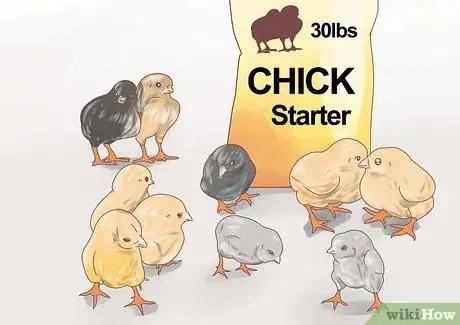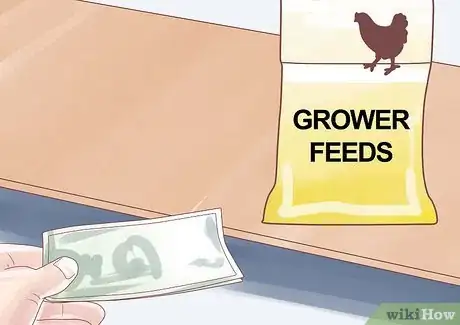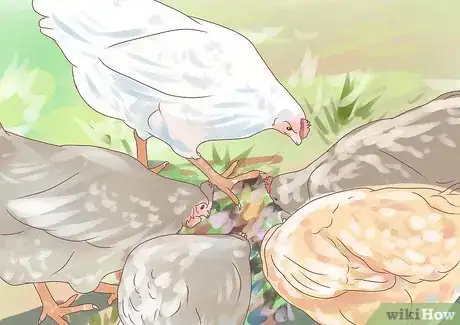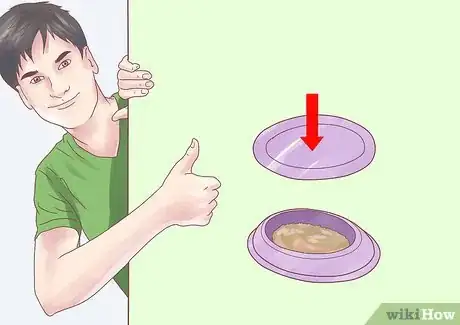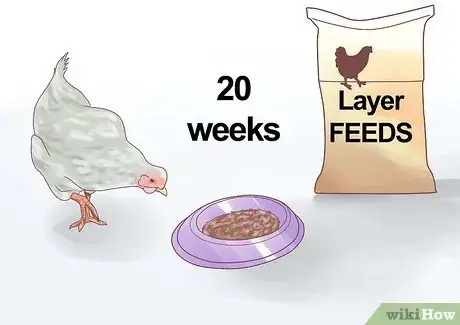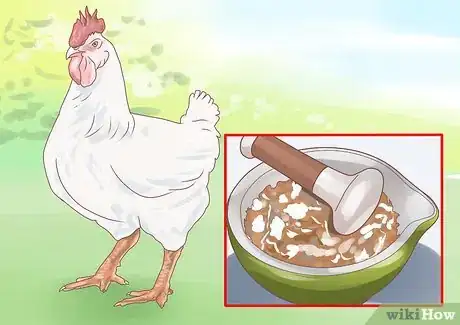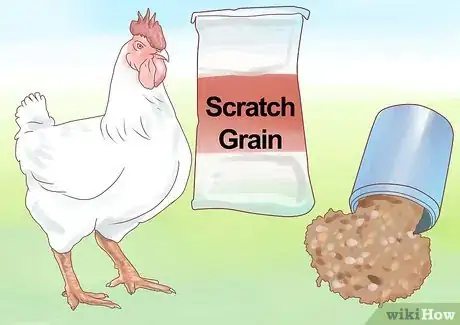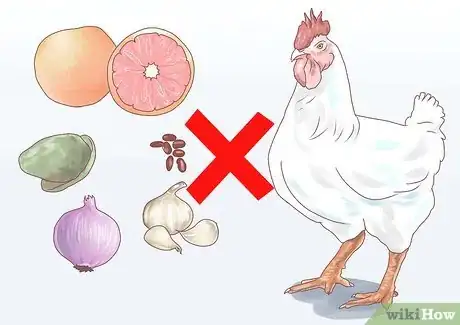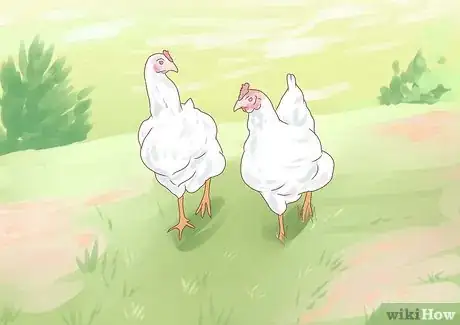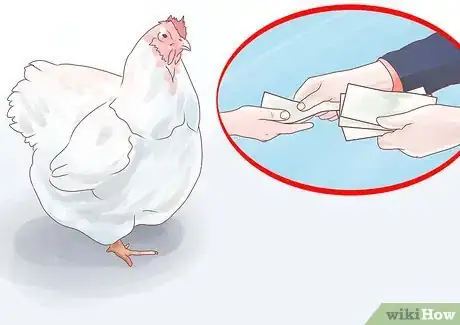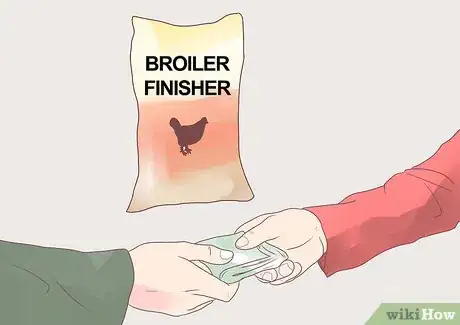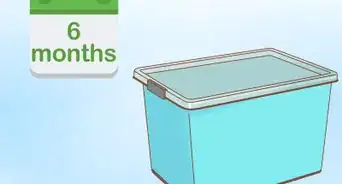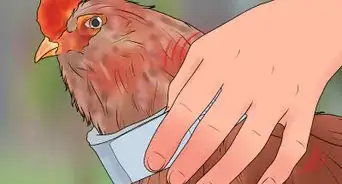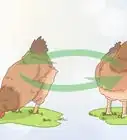This article was co-authored by Amy Harrison, a trusted member of wikiHow's volunteer community. Amy Harrison has over five years of experience working directly with poultry. She has worked on a rural chicken farm built around marketing free-range eggs, where she managed the care for the poultry year-round. She has experience breeding chickens and quail, caring for newborn poultry, handling their health issues, and managing their dietary needs.
wikiHow marks an article as reader-approved once it receives enough positive feedback. In this case, 80% of readers who voted found the article helpful, earning it our reader-approved status.
This article has been viewed 65,144 times.
Learn more...
Chickens are known for being the trash collectors of the barnyard. They will eat kitchen scraps, grains and store bought feed; however, their nutrition is always in a delicate balance. Egg layers require high calcium levels, while broiler chickens need higher protein. Change and supplement your chickens’ food as they grow and develop.
Steps
Feeding Baby Chicks
-
1Don’t feed chicks any food within one hour of their birth. Wait to start them on regular feed until they are one day old.
-
2Give newborn chicks a mixture of one gallon water to one-fourth cup sugar and possibly one tsp. of terramycin. Terramycin is an antibiotic that is used to treat bacterial infections.[1]Advertisement
-
3Purchase a starter feed from a supply store. These mixes should contain 20 percent protein, which is higher than the amount you will feed to older chickens. Feed them starter feed from day one to eight weeks old.[2]
-
4Consider purchasing a medicated starter if your chicks have suffered from coccidiosis in the past. If they have been vaccinated, choose unmedicated starter feed.
-
5Set aside about 30 lbs. (14 kg) of starter feed to feed 10 chicks for six weeks.
Feeding Growing Chickens
-
1Change the starter feed to “grower feed” purchased from a feed supply store at 8 to 10 weeks. The protein level should be around 16 percent protein. Birds that will be used for meat can have up to 20 percent protein in their grower feed.
-
2Begin giving your chickens small kitchen scraps when they are 10 weeks old or bigger. Treats should be very small, since they will replace part of the nutritious grower feed that day. Chickens can eat just about anything such as toast, cereal, biscuits, corn, noodles and even meat!
-
3Place a bowl of grit nearby. Grit helps the chickens digest vegetable and fruit treats. Purchased feed is already mixed for adequate digestion without grit and free-range chickens don't need grit as they find plenty of things in the ground that helps them digest their food.
-
4Don’t feed chickens any layer feed before 18 weeks. The calcium content can hurt the kidneys and reduce the chicken’s life span.
-
5Keep in mind that chickens only eat during the day. Cover any leftover food to protect it from pests at night. If you don't cover the food there is a chance that you will attract bugs, mice, rats and other creatures seeking for food.
Feeding Laying Hens
-
1Begin feeding your laying hens layer feed at 20 weeks of age. You can also use all-purpose feed; however, layer feed can have up to 2 percent more protein and more calcium content to promote better eggshells. You will need 18 to 24 lbs. (8 to 11 kg) of feed per week for 10 chickens.
- You can purchase layer feed in pellet, mash or crumble forms, the choice is up to you. If the eggs turn soft provide the hens with more calcium. Keep in mind that it is common for a hens first egg to be a bit unusual such as double yolks and soft shells.
-
2Provide a supplemental source of calcium in a bowl. Crushed oyster shells or crushed eggshells can increase the calcium. Never mix the calcium into the layer feed.
-
3Give your layers limited treats each week to supplement their diet. The healthiest treats are mealworms, pumpkin and pumpkin seeds. Provide a bowl of grit (unless free-range) to help them digest it.
-
4Supplement a chicken’s diet with “scratch” in the winter. They eat more when it is cold out. Scratch is made of cracked corn, oats, wheat and other grains. It should be given in limited quantity and taken away almost entirely in the summer.
-
5Don’t feed your chickens citrus fruits, salty foods, rhubarb, chocolate, onion, garlic, lawn mower clippings, uncooked beans, avocado skins or pits, raw eggs, sugar/candy or raw green potato peels. These are toxic to chickens.[3]
-
6Allow your chickens to graze around your lawn. Lawns with weeds and tender, young plants can increase nutrition. However, lawns sprayed with pesticides or featuring only one type of grass can take the place of more nutritious food sources.
- The benefits of having your chickens graze around your lawn is that they don't need to be provided grit and most of their diet is made up from the things they find inside the grass and ground.[4]
Feeding Broiler Chickens
-
1Purchase broiler starter for meat chickens until they are six weeks of age. This is different than layer starter. It has a protein content of 20 to 24 percent.
- You will need 30 to 50 lbs. (14 to 23 kg) of broiler starter for 10 chicks.
-
2Buy broiler finisher pellets to feed your chickens from six weeks until slaughter. The protein content is 16 to 20 percent. You will need 16 to 20 lbs. (7 to 9 kg) of feed for 10 birds.
-
3Consider making food available to your broiler chickens at night as well as in the day. Some birds that are bred for meat are given feed day and night, with light placed in their coops to encourage them to eat more. You may choose to do this near the end of their lives.
Community Q&A
-
QuestionCan I make my own feeds?
 Community AnswerYes, you can make your own chicken feed. You can use a variety of nuts and grains, like bread, sunflower seeds, cereal and dried corn.
Community AnswerYes, you can make your own chicken feed. You can use a variety of nuts and grains, like bread, sunflower seeds, cereal and dried corn. -
QuestionCan chickens eat chicken?
 Community AnswerYes, adult chickens can eat pretty much anything, although some people find it unsettling.
Community AnswerYes, adult chickens can eat pretty much anything, although some people find it unsettling. -
QuestionWhat foods are dangerous to chickens?
 Amy HarrisonTop AnswererDon’t feed your chickens citrus fruits, salty foods, rhubarb, chocolate, onions, garlic, lawn mower clippings, uncooked beans, avocadoes, raw eggs, sugar/candy or raw green potato peels.
Amy HarrisonTop AnswererDon’t feed your chickens citrus fruits, salty foods, rhubarb, chocolate, onions, garlic, lawn mower clippings, uncooked beans, avocadoes, raw eggs, sugar/candy or raw green potato peels.
Things You'll Need
- Water
- Sugar
- Terramycin
- Starter feed (medicated or unmedicated)
- Broiler starter feed
- Grower feed
- Layer feed
- Kitchen scraps
- Grit
- Oyster/eggshells
- Mealworms
- Pumpkin
- Pumpkin seeds
- Broiler finisher feed
- Scratch/grains
References
- ↑ http://www.tractorsupply.com/know-how_Chicken-Care_how-to-feed-chickens
- ↑ http://www.the-chicken-chick.com/2012/11/feeding-chickens-at-different-ages.html
- ↑ http://www.backyardchickens.com/a/chicken-treat-chart-the-best-treats-for-backyard-chickens
- ↑ http://kb.rspca.org.au/What-should-I-feed-my-backyard-chickens_305.html
About This Article
To feed chickens, start feeding them a grower feed once they're 8-10 weeks old. You can also start feeding them small amounts of kitchen scraps when you introduce the grower feed. Then, once your chickens reach 20 weeks, start feeding the laying hens a layer feed. If you're raising broiler chickens for meat, feed them broiler finisher pellets from 6 weeks of age until they're slaughtered. For more advice from our Poultry co-author, like how to feed baby chicks, read on!
